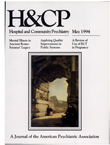Self-Infficted Eye Injuries: Case Presentations and a Literature Review
Abstract
Objective: The authorś aim was to determine demographic and clinical correlates of s]elf-inflicted eye injury. Methods: The authors reviewed 41 cases of patients with self-inflicted eye injuries identified through MEDLARS searches of medical literature for the period from 1980 to 1993 and four cases from the first author's clinicalpractice. Results: Most patients with self-inflicted eye injuries were male, about 31 years old, and had a diagnosis of schizophrenia, drug or alcohol abuse, depressive disorders, or other psychosis. Somepatients experienced cognitive distortions, often involving religious and sexual ideation, and intense fear around the time they injured themselves. Thirty-three percent of the patients with self-inflicted eye injuries also showed other types of self-injurious behavior. Conclusions: Enucleation of the eye may serve as a defense against witnessing or experiencing a forbidden act. Psychodynamic theories addressing self-mutilation do not explain self-induced eye injury particularly well but may assist the the rapist in understanding motivation and in restructuring patientsś behavior. Management of these patients requires multidisciplinary, multimodal efforts involving medical specialists, patients, family members, and staff.
Access content
To read the fulltext, please use one of the options below to sign in or purchase access.- Personal login
- Institutional Login
- Sign in via OpenAthens
- Register for access
-
Please login/register if you wish to pair your device and check access availability.
Not a subscriber?
PsychiatryOnline subscription options offer access to the DSM-5 library, books, journals, CME, and patient resources. This all-in-one virtual library provides psychiatrists and mental health professionals with key resources for diagnosis, treatment, research, and professional development.
Need more help? PsychiatryOnline Customer Service may be reached by emailing [email protected] or by calling 800-368-5777 (in the U.S.) or 703-907-7322 (outside the U.S.).



